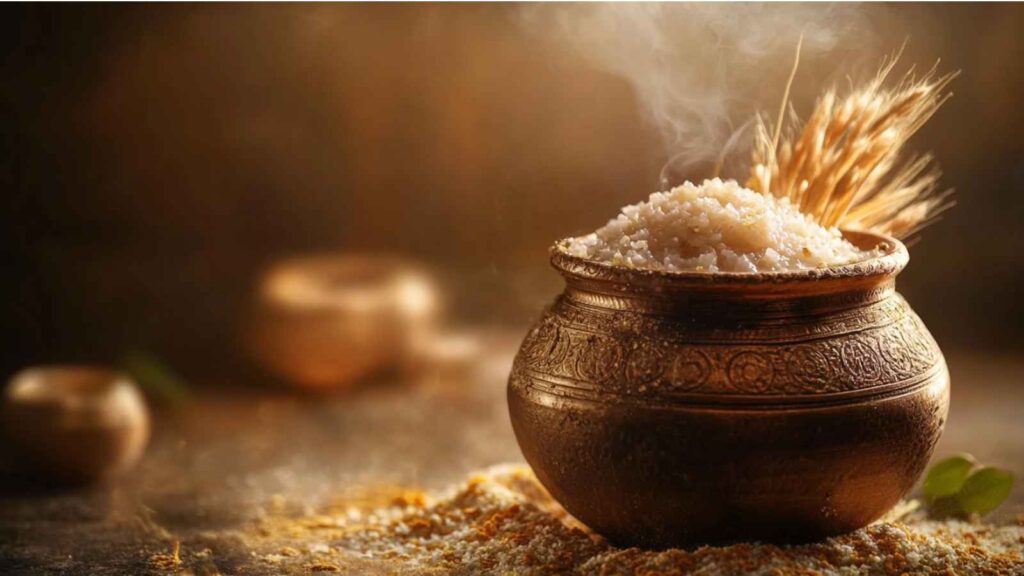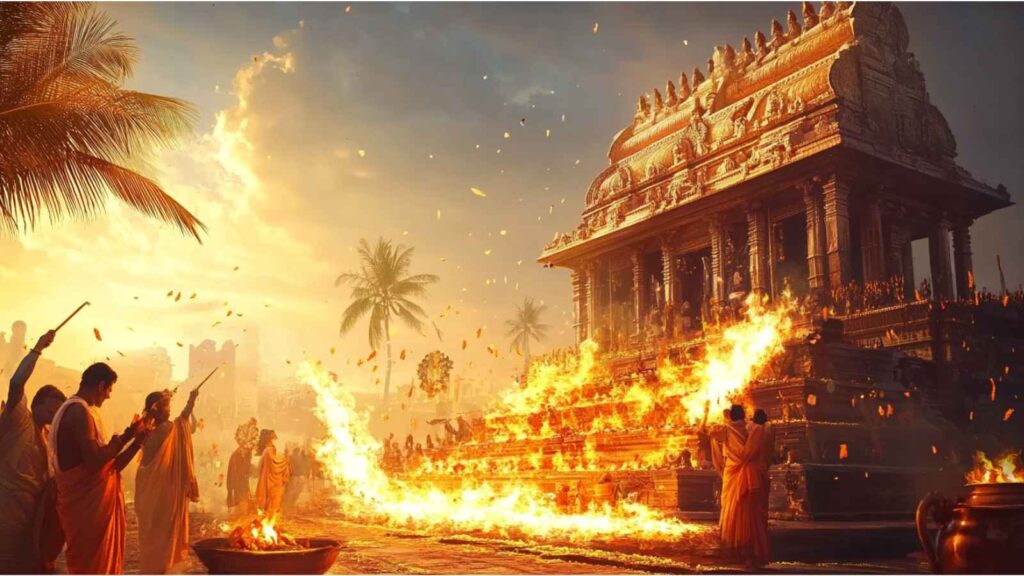Pongal: Celebrating the Harvest Festival with Sacred Scriptures, Iconic Temples & Timeless Traditions
Pongal is one of the most celebrated festivals in South India, marking a time of gratitude, renewal, and joyous celebration. Rooted in the agrarian traditions of Tamil Nadu, Pongal is a vibrant harvest festival that honors the Sun God, nature, and the earth’s bounty. It is a time when families and communities come together to cook the special Pongal dish, decorate their homes, and participate in age-old rituals that have been passed down through generations.
Read More About Hindu Philosophy
This festival is not only about the harvest—it is a spiritual celebration deeply intertwined with ancient scriptures and philosophical wisdom. Foundational texts like the Vedas, Upanishads, and regional Tamil literature guide the rituals and beliefs associated with Pongal. They remind devotees of the eternal connection between humanity and nature, emphasizing the importance of gratitude, purity, and communal harmony.
In this comprehensive guide, we explore the multifaceted dimensions of Pongal, including its mythological roots, spiritual significance, and the elaborate rituals that mark its observance. We also highlight iconic temples that become focal points of celebration during Pongal, detailing their historical backgrounds, architectural splendor, and the unique experiences they offer to visitors. Additionally, we provide a creative framework for generating captivating AI visuals that encapsulate the spirit of Pongal, ensuring that your digital content is engaging, informative, and SEO optimized.
Foundational Scriptures and Spiritual Guidance
Ancient Wisdom and Harvest Rituals
The spirit of Pongal is deeply embedded in the sacred texts and philosophical traditions of Hinduism. Although primarily an agrarian festival, Pongal’s rituals echo the timeless wisdom of ancient scriptures that extol the virtues of gratitude, purity, and cosmic balance.
The Vedas and Upanishads
- The Vedas:
The Rigveda, Yajurveda, Samaveda, and Atharvaveda form the bedrock of Hindu spiritual thought. These ancient hymns emphasize the importance of natural cycles, cosmic order (ṛta), and the interconnectedness of all life. While the Vedas do not explicitly mention Pongal, their teachings on the cycles of nature and the sanctity of the sun pave the way for the rituals that celebrate the harvest. - The Upanishads:
The Upanishads delve deeper into metaphysical concepts such as the nature of the self (Atman) and the ultimate reality (Brahman). They encourage seekers to transcend material limitations and connect with the divine essence present in every aspect of nature. This philosophy is reflected in Pongal, where the act of boiling rice with milk and jaggery symbolizes the union of earthly abundance with spiritual purity.
Tamil Literary Tradition
The rich corpus of Tamil literature, including works like the Thirukkural and ancient Sangam texts, extols virtues such as gratitude, harmony with nature, and community solidarity. These texts provide regional insights into agricultural practices and the celebration of harvest, which form the cultural backdrop for Pongal.
Regional Mythology and Ritual Texts
The rituals of Pongal are also influenced by local legends and ritual manuals that have been part of Tamil culture for centuries. These texts detail the proper methods of preparing offerings, the significance of various ingredients in the Pongal dish, and the role of the Sun God (Surya) in bestowing prosperity and abundance.
“In every grain of rice, in every drop of milk, lies the promise of life renewed—an eternal bond between nature’s bounty and the divine.”
– Traditional Tamil Proverb
The Cultural and Ritual Significance of Pongal

Pongal is celebrated over four days, each with its own significance and unique rituals. These days—Bhogi, Thai Pongal, Mattu Pongal, and Kanum Pongal—together create a festival that is both a celebration of the harvest and a time for spiritual renewal.
Day 1: Bhogi
- Celebration of Renewal:
Bhogi marks the beginning of Pongal and is a day dedicated to discarding old, unused items and celebrating new beginnings. Homes are cleaned, and bonfires are lit to symbolize the burning away of past impurities. - Ritual Practices:
Families decorate their homes with kolams (rangoli designs) and prepare traditional sweets. The bonfire ritual is not only a physical cleansing but also a spiritual act that purges negativity.
Day 2: Thai Pongal
- The Main Festival:
Thai Pongal is the most important day, named after the Tamil month ‘Thai.’ It is dedicated to the Sun God, whose energy is believed to be essential for a bountiful harvest. - The Pongal Dish:
The highlight of the day is the cooking of the Pongal dish—a sweet concoction made from newly harvested rice, milk, jaggery, and flavored with cardamom and nuts. The boiling over of the pot is seen as a symbol of abundance and prosperity. - Rituals and Offerings:
Devotees offer prayers to the Sun God and thank nature for its bounty. Traditional music, dance, and community feasts add to the festive spirit.
Day 3: Mattu Pongal
- Honoring Cattle:
Mattu Pongal is dedicated to cattle, which are indispensable in agricultural work. Cows and bulls are bathed, decorated, and honored with special offerings. - Cultural Performances:
In many villages, competitive events such as bull-taming and decorative processions are organized, reflecting the integral role of cattle in rural life.
Day 4: Kanum Pongal
- Social and Recreational Day:
Kanum Pongal is a day for socializing and visiting relatives. Many families take this opportunity to go on picnics, fly kites, and enjoy the company of loved ones. - Community Bonding:
This day fosters a sense of community and togetherness, reinforcing the importance of family and social bonds.
Iconic Temples Celebrating Pongal

While Pongal is primarily a harvest festival, it is also a time when devotees visit temples to seek blessings for prosperity, good health, and spiritual renewal. Below are three iconic temples associated with Pongal celebrations, each offering a unique glimpse into the region’s spiritual heritage.
1. Konark Sun Temple, Konark, Odisha
Location:
Konark Sun Temple
Address: Konark, Odisha, India, 752110
Historical Background:
Built in the 13th century by King Narasimhadeva I of the Eastern Ganga dynasty, the Konark Sun Temple is a UNESCO World Heritage Site. This temple is dedicated to Surya, the Sun God, whose blessings are central to the Pongal festivities. Historically, the temple served as both a place of worship and an astronomical observatory, reflecting the sophisticated knowledge of ancient Indian architects and astronomers.
Architectural Highlights:
- Iconic Chariot Structure:
The temple is designed in the shape of a colossal chariot with intricately carved stone wheels, pillars, and walls that depict various aspects of life, nature, and mythology. - Intricate Sculptures:
The carvings on the temple walls showcase a myriad of deities, celestial beings, and mythological narratives, symbolizing the cosmic journey of the Sun. - Symbolism of Light:
The architectural design is intended to capture and reflect the movement of the sun, reinforcing the temple’s role as a beacon of divine light and energy.
Visitor Experience:
Visitors to Konark Sun Temple during Pongal are captivated by its awe-inspiring architecture and the rich cultural history it embodies. The temple’s majestic presence, set against the backdrop of the Bay of Bengal, offers a serene yet powerful reminder of the ancient traditions that continue to influence modern celebrations. Guided tours and interpretive displays help visitors appreciate the temple’s historical significance and its connection to the harvest rituals of Pongal.
2. Sri Surya Mandir, Kumbakonam, Tamil Nadu
Location:
Sri Surya Mandir
Address: Kumbakonam, Tamil Nadu, India, 612501
Historical Background:
Situated in the culturally rich town of Kumbakonam, Sri Surya Mandir is an ancient temple dedicated to Surya, the Sun God. Believed to have been established during the Chola dynasty, this temple has long been a center for worship and scholarly pursuits. It plays a significant role in the Pongal celebrations, as devotees seek the blessings of the Sun God for a prosperous harvest and overall well-being.
Architectural Highlights:
- Dravidian Architectural Style:
The temple features the distinctive Dravidian style with towering gopurams (gateway towers), elaborate pillared halls, and intricately sculpted deities adorning its walls. - Celestial Motifs:
Numerous carvings and murals depict solar motifs, mythological scenes, and allegorical representations of nature’s bounty. These artistic elements highlight the temple’s deep connection to the themes of light and growth celebrated during Pongal. - Harmonious Layout:
The temple’s design follows the principles of Vastu Shastra, ensuring that every aspect of the structure harmonizes with cosmic energies and fosters a serene atmosphere for worship.
Visitor Experience:
A visit to Sri Surya Mandir during Pongal offers a blend of spiritual reflection and cultural immersion. Devotees are drawn to the temple’s tranquil ambiance, where the sounds of devotional hymns and the scent of burning incense create an atmosphere of deep reverence. Local guides share fascinating stories about the temple’s history and its role in the annual harvest celebrations, enhancing the overall visitor experience. The temple’s vibrant festivals, especially during Pongal, make it a must-visit destination for both spiritual seekers and cultural enthusiasts.
3. Suryanar Kovil, Villianur, Puducherry
Location:
Suryanar Kovil
Address: Villianur, Puducherry, India, 605007
Historical Background:
Suryanar Kovil is an ancient temple dedicated to Surya, located in the serene locale of Villianur in Puducherry. With roots tracing back to early centuries, the temple has been an integral part of the local cultural and spiritual landscape. It has been revered by generations of devotees for its association with solar worship and the harvest season, making it a focal point during Pongal celebrations.
Architectural Highlights:
- Fusion of Styles:
The temple showcases a unique blend of traditional Dravidian architecture with subtle influences of French colonial design, reflective of Puducherry’s diverse cultural heritage. - Ornate Sculptures and Murals:
Detailed sculptures of the Sun God and other deities adorn the temple’s walls, while vibrant murals narrate mythological tales associated with solar divinity and nature’s abundance. - Sacred Ambiance:
The use of natural stone, intricate carvings, and the careful alignment of structures according to Vastu Shastra create an environment that is both spiritually uplifting and aesthetically pleasing.
Visitor Experience:
Visitors to Suryanar Kovil during Pongal experience a blend of calm spirituality and rich cultural heritage. The temple’s peaceful surroundings, coupled with the lively celebrations during the harvest festival, offer a unique experience that is both meditative and invigorating. Devotees appreciate the temple’s historical legacy and the vibrant rituals that mark Pongal, making it an ideal destination for those seeking to immerse themselves in traditional worship and communal celebrations.
